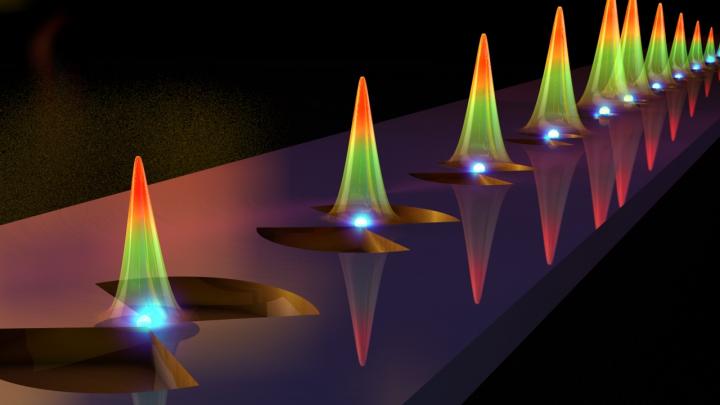Bowtie-funnel combo best for conducting light; team found answer in simple equation

The team developed structure that's part bowtie, part funnel that conducts light powerfully and indefinitely, as measured by a scanning near field optical microscope. Credit: Ella Maru Studio
A Vanderbilt team found the answer in a formula familiar to college physics students – a solution so simple and elegant, it was tough for reviewers to believe. Professor Sharon Weiss, her Ph.D. student, Shuren Hu, and collaborators at the IBM T. J. Watson Research Center and University of Technology in Troyes, France, published the proof in today's Science Advances, a peer-reviewed, open-access journal from AAAS.
They developed a structure that's part bowtie, part funnel that concentrates light powerfully and nearly indefinitely, as measured by a scanning near field optical microscope. Only 12 nanometers connect the points of the bowtie. The diameter of a human hair is 100,000 nanometers.
“Light travels faster than electricity and doesn't have the same heating issues as the copper wires currently carrying the information in computers,” said Weiss, Cornelius Vanderbilt Endowed Chair and Professor of Electrical Engineering, Physics and Materials Science and Engineering.
“What is really special about our new research is that the use of the bowtie shape concentrates the light so that a small amount of input light becomes highly amplified in a small region. We can potentially use that for low power manipulation of information on computer chips.”
The team published its work as a theory two years ago in ACS Photonics, then partnered with Will Green's silicon photonics team at IBM to fabricate a device that could prove it.
The research began with Maxwell's equations, which describe how light propagates in space and time. Using two principles from these equations and applying boundary conditions that account for materials used, Weiss and Hu combined a nanoscale air slot surrounded by silicon with a nanoscale silicon bar surrounded by air to make the bowtie shape.
“To increase optical energy density, there are generally two ways: focus light down to a small tiny space and trap light in that space as long as possible,” Hu said. “The challenge is not only to squeeze a comparatively elephant-size photon into refrigerator-size space, but also to keep the elephant voluntarily in the refrigerator for a long time. It has been a prevailing belief in photonics that you have to compromise between trapping time and trapping space: the harder you squeeze photons, the more eager they are to escape.”
Weiss said she and Hu will continue working to improve their device and explore its possible application in future computer platforms.
###
This work was funded by National Science Foundation GOALI grant ECCS1407777.
Video: https:/
Media Contact
All latest news from the category: Information Technology
Here you can find a summary of innovations in the fields of information and data processing and up-to-date developments on IT equipment and hardware.
This area covers topics such as IT services, IT architectures, IT management and telecommunications.
Newest articles

Security vulnerability in browser interface
… allows computer access via graphics card. Researchers at Graz University of Technology were successful with three different side-channel attacks on graphics cards via the WebGPU browser interface. The attacks…

A closer look at mechanochemistry
Ferdi Schüth and his team at the Max Planck Institut für Kohlenforschung in Mülheim/Germany have been studying the phenomena of mechanochemistry for several years. But what actually happens at the…

Severe Vulnerabilities Discovered in Software to Protect Internet Routing
A research team from the National Research Center for Applied Cybersecurity ATHENE led by Prof. Dr. Haya Schulmann has uncovered 18 vulnerabilities in crucial software components of Resource Public Key…





















